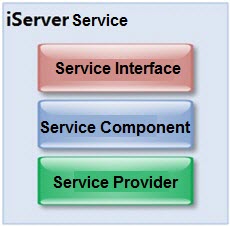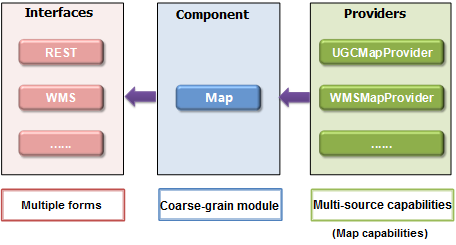
Services introduction |
SuperMap iServer adopts service-oriented architecture (SOA) that emphasizes on encapsulating different functional units as services. Interfaces exposed by services regulate functional and non-functional functions and features through contracts to implement business integration and interoperation on the WAN (like Internet) environment with unrestricted platform environment and easy reuse.
SuperMap iServer provides the following types of services:
SuperMap iServer can publish services mentioned above using data from multi-sources, such as SuperMap workspace data, remote WMS service, remote WFS service, remote REST map service, and so on.
Table 1 Sources of SuperMap iServer Service
|
GIS Function |
Service Type | Sources |
| Map Function | Map REST Service | SuperMap workspace data, remote WMS services, remote SuperMap WMTS services, remote REST Map services, SuperMap cloud services, Bing Maps services, Tianditu services, MBTiles files, etc. |
| WMTS Service | ||
| WMS Service | ||
| Data Function | Data REST Service | SuperMap workspace data, remote WFS services and REST Data services. |
| WFS Service | ||
| WCS Service | ||
| Analysis Function | Spatial Analysis REST Service | SuperMap workspace data and REST Spatial Analysis services. |
| Transportation Analyis REST Service | SuperMap workspace data and REST Transportation Analysis services. | |
| Traffic Transfer Analysis REST Service | SuperMap workspace data and REST Traffic Transfer Analysis services. | |
| WPS Service | SuperMap workspace data. | |
| 3D Function | 3D REST Service | SuperMap Workspace Data and REST 3D services. |
| 3D Network Analysis REST Service | SuperMap workspace data. | |
| Plotting Function | Plotting REST Service | Plot files. |
All of GIS functions in SuperMap iServer can be encapsulated as services which are loosely coupled, focusing on interoperation. These services may combine with components, applications or other services in a certain way. A service in SuperMap iServer consists of three parts: service interfaces, service components ,and service providers.

SuperMap iServer uses service components to encapsulate functions provided by service providers, and publish service components as various types of service. A service compoent can use several service providers, and can publish various types of service. Take Map service component as an example to illustrate the relations among service components service interfaces and service providers.

GIS Service Component contains Generic Spatial Service and Domain Spatial Service. Generic Spatial Service refers to the common GIS services, like map service, spatial data service, spatial analysis service, network analysis, and so on. Domain Spatial Service describes relative services of GIS on the specific industries, and users make secondary development and configuration on generic spatial service to add their own business logic, which will design a spatial service satisfying with the special demand of a certain industry, thus achieving the multi-layer reusage of generic spatial service in the specific fields. For example, for the meteorological field, based on the generic spatial service, plus weather report service, meteorology warning service, etc., it will design the meteorology field service that meets that field's demands. Users enable to look for the weather condition in one city using this service, and display the result on the map, or look for which areas are in the warnings state.
The condition of A service configuration, including the use of service components, service providers and service interfaces, are implemented by configuration management module of SuperMap iServer. For more information about service configuration, see Service configuration.